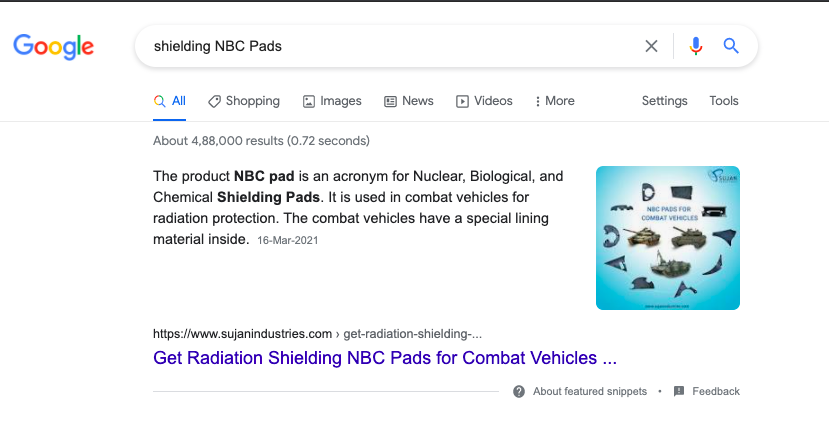Winning the Google SERP features is a tough row to hoe for SEO experts all around the world. Lots of digital marketing company worldwide have been trying to crack the nut for a long time. Some became successful, while others are still wondering. So here in this blog, we’ll discuss the major SERP features and the implicit ways to win them. But before we dive deeper, let’s start from scratch.
SERP: What’s that?
SERP is the acronym for the Search Engine Result Page. Whenever a user searches for something on Google using a certain keyphrase, it generates a result page. On that result page, the user can find the possible sources to solve his/her query. So this page is called the Search Engine Result Page.
Needless to say, there are a lot of result pages on Google, not just one. But the maximum click goes to the top results featured on the first SERP. However, the content of the Google SERP includes paid results, organic results, and SERP features.
Paid results are the paid ads of certain websites that are relevant to the search keyword. These ads come at the top and bottom of any result page. Organic results are the ones that show up on the SERP naturally. And Google SERP features are something that we are going to discuss below.
What are Google SERP Features?
SERP features are some additional elements on the SERP besides that typical format with blue links to the websites and descriptions. These features add something new to the traditional format of the SERP. The purpose of these features is to ensure a more user-friendly experience on Google’s result page.
Although the name “SERP features” is not official; Google calls it by different names like “rich results,” “search results features,” “enriched search results,” “interactive rich result” etc. However, the name “SERP features” is more widespread. So we prefer using that name in this blog.
Some Major Google SERP Features and Ways to Win them
1. Featured Snippets
A featured snippet is an organic result where Google extracts the content from a landing page to reply to a user’s query. The content that Google considers to be the most concise, written in a specific way, and solves the query, shows up on the featured snippet.
Generally, Google displays only one Featured Snippet per query. And the site, from where Google extracts the information, must already have a rank between the numbers one and five. Hence it’s a competitive sport for the brands for each keyphrase.
So if you are struggling to grab the Featured Snippet spot on Google but unable to get through, reach out to the top SEO company in India for in-depth analysis and actionable insights.
Here’s an example of Google Featured Snippet for your better clarity.

How to grab the Featured Snippets spot?
- Optimize your web page more for the keyword.
- Then write content in a more clear and precise way.
- Also, use simple language to describe the topic.
- Always write better content than your competitors.
2. Local Pack:
The SERP shows up a Local Pack that has three physical locations, for the keywords that Google considers to have more local search intent and is most relevant to the keyword. Especially on mobile, these features dominate the search result page. Here you’ll get to see handy details about the places you’ve searched for like opening hours, price range, address, contact information, user ratings, and reviews, etc.
Check out the image below.

How to get featured on the Local Pack?
- Optimize your Google My Business (GMB) profile with relevant keywords and information.
- Include the same information on your website as well.
- Also, get your business listed on other local directories.
3. In-depth Article
If the search is regarding some broad and ambiguous term, Google often shows up a block of in-depth articles. These articles are almost indistinguishable from the organic search results. Also, these are dominated by authoritative and large publishers and might have a different ranking rule than the basic organic results. However, for each blog of three articles, there is only one organic rank.
How to get a spot on the In-depth Article?
- The content must have 2000-5000 words.
- There has to be an authorship markup.
- The article must have schema article markup.
- Last but not the least, the writing must be unique and of top quality.
4. Related Questions
The Related Questions are something that Google assumes to be relevant to your search. These questions are algorithmically generated. Each question shows something that looks similar to the featured snippet.
Primarily, this feature starts with a list of four questions and later expands with more questions as one clicks on one question to read more. Although the placement of the feature, Related Questions on the SERP might vary, Google always picks them from the organic results.
However, Related Questions are also taken to be the keywords with Featured Snippets. So the website that gets the spot for Featured Snippets, also gets the spot for Related Questions. Also, you can consult the SEO experts at the best digital marketing company in Mumbai for more tips on the same.
5. Reviews
Reviews and yellow rating stars come with an image and show up mainly for recipes, products, and other relevant items. On the SERP it’s placed between the destination URL and the featured snippet. The search results that have review stars get the higher CTR.
How to get a spot on the Review Snippet?
- Make sure the content of your web page has the schema markup.
6. Site links
When you search for an exact domain on Google, it clearly means that you want to land on some brand’s website. So then Google displays an expanded pack of up to 10 site links. This entire pack of site links involves five organic positions that dominate the SERP.
This can help your website by generating a higher CTR from the SERP. Moreover, it can take your users quickly to the page they are looking for, thereby improving the user experience. However, site links generally appear on large branded websites with higher traffic.
How to enable site links on your website?
- Implement the structured data correctly on your website.
7. Knowledge Panel
A knowledge panel or knowledge graph is the feature that extracts semantic data from a few sources on the internet. These sources can be human-edited sources like WikiData, Wikipedia, Google Index, and private data partnerships as well. For a desktop search result, a Knowledge Graph appears on the right side of the organic search results. Whereas for mobile search, it appears on the top of the result page.
How to enable Knowledge Graph?
- Learn how Google stores entity data about anything and everything on earth.
- Also, learn which keywords are impacted by Knowledge Graph results.
- Then prioritize those keywords to target in your content.
8. Image Pack
Image packs show up on the SERP as a horizontal row of image links. They click through to the Google Images search. This feature may display in any organic position. Since images are visually compelling, getting featured on Google Image Pack can help keep your brand front and center.
Image packs use the ranking rule that is beyond the basic organic algorithm. They appear when Google assumes that visual content can be more valuable to a specific search result.
How to get a spot on the Google Image Pack?
- Optimize the size of your image properly.
- Also, use a descriptive file name.
- The Alt Text has also to be descriptive.
- Then write a human-readable URL
- Don’t forget to include the title attribute as well.
- And reach out to the top SEO company in India for more help.
9. Video pack
Videos these days are getting extensive popularity for driving brand awareness, engagement, and SEO as well. On the Google SERP, almost all videos are pulled from YouTube. Hence it’s essential you get a YouTube channel and publish quality video content there. Only fully optimized videos with great content have the chance to get featured on the Video Pack. However, video results on the SERP will display the thumbnails.
How to get a spot on the Google Video Pack?
- Optimize the video with the right keywords.
- Then give an optimized filename.
- Also, write an optimized and engaging title and description.
- Don’t forget to get a full and optimized video transcript.
- Ensure the video schema markup exists on the page.
Conclusion
To sum up, winning the SERP features is not tough if you have the right plan and are willing to put the right effort into your website. Follow these guidelines to show your brand’s website upon the Google SERP features and get more visibility, organic traffic, and increased business. For more assistance, Get in Touch with us.

